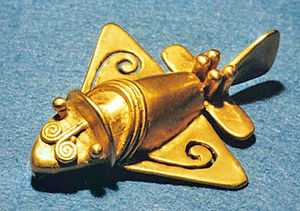Quimbaya artifacts

The Quimbaya artifacts are several dozen golden objects, found in Colombia, made by the Quimbaya civilization culture, dated around 1000 CE, a few of which (the so-called Quimbaya airplanes) are supposed by ancient astronauts theorists to represent modern airplanes, and therefore to be out-of-place artifacts. The whole of the figurines, measuring 2 to 3 inches (5 to 7.5 cm) each, are described in mainstream archaeology as depicting birds, lizards, amphibians and insects common in that region and period, some of them highly stylized, as in the Gold Museum, Bogotá.
In 1994, Germans Peter Belting and Conrad Lubbers created simplified radio-controlled scale models of these objects and showed that their models, which lack some convoluted features present in the real figurines, could fly.[1]
Critics of the modern-day airplane interpretation argue that the pre-Columbian culture in South America did not have the knowledge nor the technology to manufacture airplanes, and that the metal artifacts these cultures created were generally ornamental in nature or were small practical objects like knives. When these artifacts are compared to other similar artifacts of the time, most of them have been identified as fish or insects. The few that have not been positively identified with a specific animal does not constitute a big enough sample of the artifacts population to draw or extrapolate any significant statistical conclusions.[2]
See also
- Quimbaya culture
- Saqqara Bird
References
- ↑ Thomas, Robert Steven (2011). Intelligent Intervention. USA: Dog Ear Publishing. pp. 74–77. ISBN 978-1-4575-0778-6.
- ↑ Johnson, Samantha. "Ancient Airplanes Sleep With the Fishes". ANP491: temples, tombs, & spaceships - Student Blog Posts. Retrieved 16 March 2013.